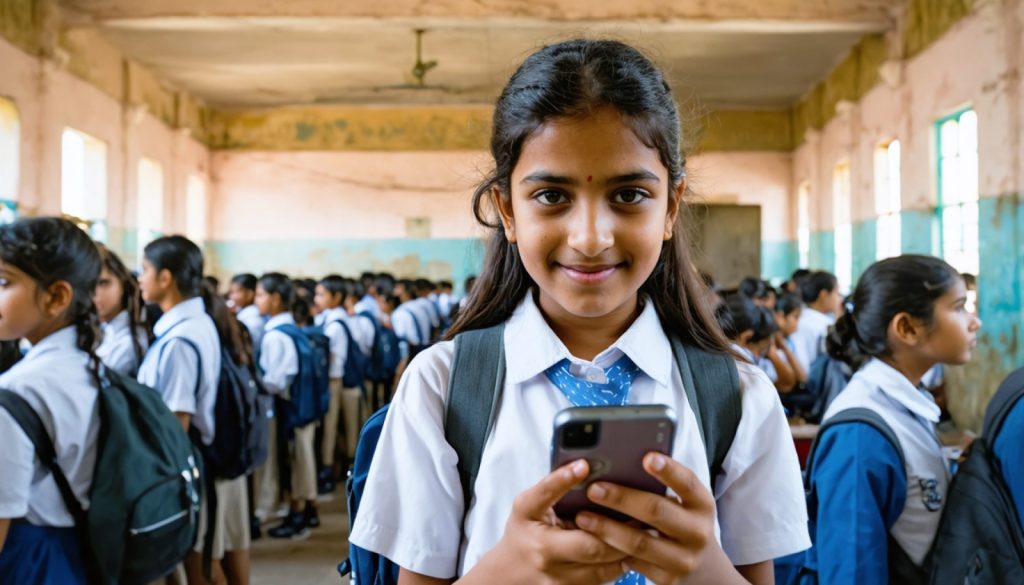
- The Delhi government mandates schools to create custom policies for mobile phone use, balancing educational benefits and potential distractions.
- The Delhi High Court emphasizes judicious use of smartphones in schools, following a student’s petition for clarity.
- Schools are encouraged to tailor policies, incorporating tech-friendly zones or strict guidelines to maintain educational focus.
- The education department’s initiative calls for collaborative policy creation involving teachers, parents, and students.
- Effective policy implementation will influence students’ academic experience and cognitive development.
- Delhi’s efforts highlight the need for careful integration of technology in education, serving as a model for schools globally.
- The aim is to ensure technology enhances rather than detracts from learning, fostering intellectual rigor and technological fluency.
A new chapter in the educational narrative unfolds in Delhi, where the striking dichotomy of opportunity and caution dances around the omnipresent smartphone. The recent mandate from the Delhi government for schools to devise bespoke policies on the use of mobile phones within their premises paints a vivid picture of modern education’s conundrum: how to harness the power of technology without succumbing to its potential perils.
Visualize a classroom, vibrant with curiosities yet potentially fragile under the weight of unchecked digital distractions. Schools across the city, from government institutes huddled in bustling lanes to elite private campuses nestled in sprawling greens, face a decisive moment. They must navigate the judicial mandate which, on March 3, conveyed that smartphones, if used judiciously, pose no inherent threat to education’s sanctity.
The Delhi High Court’s ruling, orchestrated by Justice Anup Jairam Bhambhani, arose from a student’s petition seeking clarity. The court’s intention, keenly focused on fostering a balanced environment, emphasized guiding principles that empower schools to tailor their approaches. These principles are not mere prescriptions but are alive with a spectrum of possibilities. A school might see fit to designate tech-friendly zones where learning and digital exploration coexist, while others might opt for stringent guidelines to maintain a steadfast focus on tactile educational experiences.
Imagine the kaleidoscope of scenarios playing out: a math lesson enriched by instant access to global educational resources or a history class where students virtually traverse ancient ruins. Yet the crux of the matter lies in discipline and discretion—how schools implement their policies will shape not only students’ academic experiences but also their broader cognitive development.
The education department’s directive, dated April 17, 2025, serves as a clarion call for educational leaders to engage their communities—teachers, parents, and students—in policy creation. With careful deliberation, these policies could redefine the balance of analog and digital in education, ensuring that technology acts not as a diversion but as a dynamic educational ally.
In this era where lines between the real and virtual blur, the takeaway for educators worldwide is clear: Technology must be channeled with forethought and care. As Delhi’s schools embark on this policy-making journey, they set a precedent for educational institutions everywhere to craft environments that nurture both intellectual rigor and technological fluency.
Unlocking the Power of Smartphones in Education: Delhi’s Innovative Approach
Introduction
In a significant move for education in Delhi, schools have been tasked with developing personalized policies regarding the use of mobile phones on their premises. This decision by the Delhi government underscores the dual nature of smartphones as both educational tools and potential distractions. The ruling aims to harness the power of technology while mitigating the risks associated with unchecked digital usage.
How-To Steps & Life Hacks
Creating Effective Mobile Phone Policies:
1. Engage Stakeholders: Involve teachers, parents, and students in the policy-making process to ensure diverse perspectives.
2. Define Objectives: Clearly outline how and when smartphones can enhance educational experiences.
3. Identify Tech-Friendly Zones: Designate specific areas or times where smartphone usage is permitted for educational purposes.
4. Ensure Accountability: Implement monitoring systems and regular evaluations to adapt policies as needed.
5. Educate Students: Teach digital literacy and responsible usage to empower students to use technology wisely.
Real-World Use Cases
1. Interactive Learning: Schools can use smartphones to facilitate access to real-time information and interactive educational apps.
2. Enhanced Research: Students can instantly access online databases and global resources, enriching their research capabilities.
3. Virtual Field Trips: Utilize augmented reality (AR) apps to transport students to historical sites or scientific environments without leaving the classroom.
Market Forecasts & Industry Trends
The global educational technology market continues to grow rapidly, with an increasing emphasis on integrating smartphones into learning environments. According to a report by MarketsandMarkets, the edtech market is expected to reach $404 billion by 2025. Schools embracing technology effectively could see improved educational outcomes and student engagement.
Reviews & Comparisons
Pros of Smartphone Usage in Classrooms:
– Instant access to vast educational resources.
– Interactive and personalized learning experiences.
– Prepares students for a tech-driven world.
Cons:
– Potential for distraction if not managed properly.
– Issues related to digital equity and access.
– Challenges in monitoring usage effectively.
Features, Specs & Pricing
Smartphones today come equipped with various features ideal for educational use, including high-speed internet connectivity, educational apps, and AR/VR capabilities. Selecting the right devices involves balancing performance needs with budget constraints.
Security & Sustainability
Security Considerations:
– Ensure strong internet security protocols are in place to protect student data.
– Educate students on safe browsing practices.
Sustainability:
– Plan for device recycling and sustainability initiatives to minimize environmental impact.
Insights & Predictions
As schools in Delhi pioneer this balanced approach, other regions may follow suit, leading to more dynamic and digitally integrated learning environments. It is predicted that schools globally will increasingly adopt similar policies, spurring technological innovation in education.
Quick Tips for Immediate Implementation
1. Start Small: Pilot the program in a few classrooms before school-wide implementation.
2. Leverage Technology: Use apps that limit non-educational content and enhance control over device usage.
3. Provide Training: Offer workshops for teachers to effectively integrate smartphones into curriculum planning.
Conclusion
As Delhi schools set a precedent for responsible smartphone integration into education, the world watches with interest. By striking a careful balance, they pave the way for a future where digital fluency and traditional learning coexist harmoniously.
For more insights on educational developments and innovative learning strategies, visit the Delhi Government’s official website.



